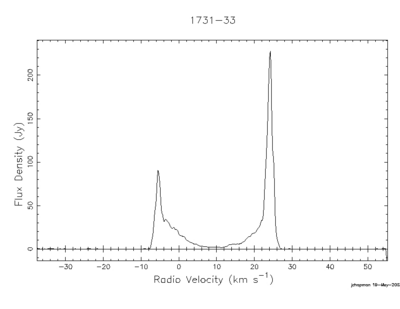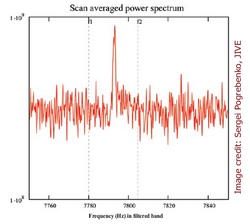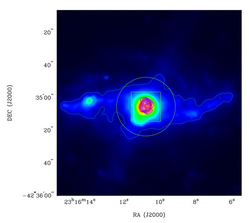ATNF Science Highlights 2005
Multibeam pulsar surveys at Parkes
Pulsar surveys using the 13-beam multibeam receiver at Parkes have been extraordinarily successful. Since the receiver was installed in 1997, surveys using it have discovered about 850 pulsars, or more than half of the total now known. The system operates at a centre frequency of 1375 MHz with a bandwidth of nearly 300 MHz. The 26 signals (two polarisations from each beam) are fed to a large filterbank system and the detected signals are recorded on tape for later analysis. Several surveys have been undertaken with the system: the Parkes multibeam pulsar survey (PMPS), a large international collaboration which surveyed a 10° strip along the Galactic plane, two surveys at Galactic higher latitudes managed by Swinburne University, a high-latitude survey by the PMPS team and a survey of the Magellanic Clouds. The PMPS alone has discovered more than 750 pulsars making it by far the most successful pulsar survey ever. The high-latitude surveys were optimised for discovery of millisecond pulsars and discovered more than 20 of this important class of pulsars, including the now famous double pulsar. Several new classes of pulsar were discovered by the PMPS, including highly magnetised, young but long-period pulsars, and RRATs, rotating radio transients which appear to just emit occasional single pulses. The double pulsar is a fascinating system with a highly relativistic orbit enabling unprecedented tests of gravitational theories as well as providing unique insight into the magnetospheric physics of pulsars.read more
|
 |
Discovery of a planetary nebula around the OH/IR star V1018 Sco
The Compact Array has been used to observe a unique, recently formed planetary nebula that is associated with a long-period OH/IR variable star, V1018 Sco. This star is still in the asymptotic giant branch stage of evolution and the OH maser emission varies periodically as the central star pulsates over a cycle of 1500 days. The star has a strong stellar wind and an extremely large OH shell. Radio continuum observations taken with the Conmpact Array show two regions of continuum emission. Both are nonthermal, with radio spectral indices comparable to those seen in colliding-wind Wolf-Rayet binaries. For V1018 Sco the nonthermal radio emission also indicates a wind-wind collision, but in this case the collision is between a cool slow wind and a hotter faster wind that has recently turned on from the same star. read more
|
 |
Shining a bright light on cold gas in the Magellanic Clouds
Our nearby neighbour galaxies, the Large (LMC) and Small Magellanic Clouds (SMC) are ideal laboratories to probe the state of the different gas phases in galaxies. Stars are born from dense and cold gas, mainly in molecular form. In turn, young massive, newly born stars dump enormous amounts of energy back into their natal gas clouds, changing its parameters in the process. This drastically disturbs the ability of molecular gas clouds to further form stars. In the LMC, 30 Doradus is such a very prominent region of star formation and energy feedback. A long string of molecular clouds is stretching away from 30 Doradus, which are ideal circumstances to probe the state of the molecular gas in regions with high flux of ionising, ultraviolet (UV) photons from young stars and much quieter environments. As a large survey, we observed the abundant carbon monoxide (CO) molecule with the AT Mopra telescope over this very extended region. We find that the sizes of molecular clouds are strongly influenced by the UV photons and that CO tends to be destroyed more readily than the more abundant hydrogen molecule (H2). This has implications on estimates of the molecular gas content and hence the potential to form stars in galaxies observed in the very far and early Universe. read more
|
 |
Pinpointing Huygens: VLBI observations of the probe s descent
On 14 January 2005 the European Space Agency (ESA) Huygens probe descended on to the surface of Saturn's moon, Titan. During the descent and for the three hours that the probe continued transmitting after it landed on the surface, the ATNF radio telescopes - Parkes, the Compact Array and Mopra, along with the University of Tasmania's telescopes in Hobart and Ceduna and 12 other telescopes in the USA, China and Japan were used to track the trajectory of the descent using the technique of Very Long Baseline Interferometry (VLBI). The position of the probe can be determined to an accuracy better than 1~km every minute - from a distance of over 1 million km. read more
|
 |
Supersonic jets from massive stars
Now equipped with new 12- and 3-mm receivers, the Australia Telescope Compact Array can measure the flux of an astronomical source over discrete wavebands spanning the frequency range 1 to 100 GHz. In an ongoing project, Brooks and her collaborators are using this valuable capability of the Compact Array to study one of the most massive young stellar objects known to harbour a supersonic jet of ionised gas. The jet is associated with the infrared source IRAS 16547-4247, located at a distance of 2.9 kpc and which has a bolometric luminosity that is equivalent to that of a single O8 zero-age-main-sequence star. This is the first reported case of a radio jet associated with a young O-type star, supporting the notion that the accretion mechanism that produces jets in low-mass star formation also operates in the higher-mass regime. read more
|
 |
Compact Array images dense gas in a circumnuclear ring
The ATCA, with its 3 mm receivers and hybrid array configurations, has opened up new avenues to investigate the nature of molecular gas at the centres of galaxies with high angular resolution and sensitivity. HCN and HCO+ are two molecules tracing high density gas (above 104 particles per cubic centimetre), with emission lines at 88.3 and 88.9 GHz. We have used both transitions to image the distribution of dense molecular gas in the central regions of NGC 1433 and NGC 7552. The distribution of the gas can be compared with that of the massive stellar population as derived from HST UV imagery. Such a comparison enables us to determine the conditions of molecular gas in areas of massive star formation. read more
|
 |
|